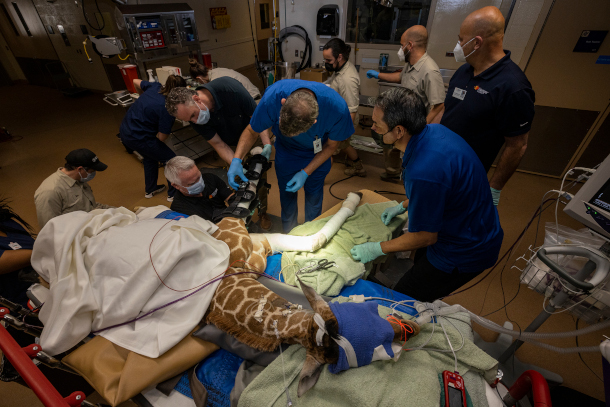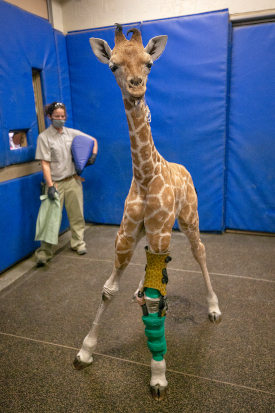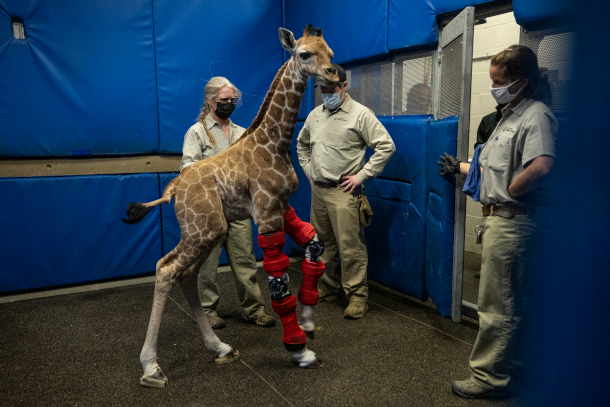A Leg Up for a Baby Giraffe
Air Date: Week of July 29, 2022

Msituni the giraffe was born in February of 2022. (Photo: Ken Bohn, courtesy of San Diego Zoo Safari Park)
A baby giraffe at the San Diego Zoo Safari Park named Msituni was born with a disability that gave her trouble walking. So her veterinary team found a creative way to help her heal. Matt Kinney, senior veterinarian at the Safari Park, joins Host Jenni Doering to talk about Msituni and her special leg braces.
Transcript
DOERING: The tallest animals on Earth today are, of course, giraffes, which can grow up to 20 feet tall. Their six-foot legs need to be strong and sturdy to carry around a couple thousand pounds or more in body weight. So when one newborn giraffe at the San Diego Zoo Safari Park was having trouble walking, her caretakers knew they had to help. They fitted little Msituni, whose name means “in the forest” in Swahili, with special leg braces made just for her. Matt Kinney is senior veterinarian at the San Diego Zoo Safari Park, and he led the team that cared for baby Msituni. He joins me now from San Diego – Matt, welcome to Living on Earth!
KINNEY: Thanks, Jenni, how you doing?
DOERING: Good, thank you. So could you tell us a little bit about Msituni, please, this giraffe that was born just this year?
KINNEY: Yeah. Msituni was born February 1 of 2022. And she was born in one of our large field habitats to a first-time mother. And essentially, within hours of her birth, we recognized that there were some concerns with her forelimbs that required some veterinary intervention. We have a very talented group of wildlife care specialists that keep close eyes on the animals at all times. And they were able to very quickly detect that Msituni was unable to ambulate normally. It is her wrist joint, that's concerning her. But what's a little bit curious about that is it looks like a human knee joint, both in size and the way that it flexes and extends, and it actually goes in the same direction as a human knee joint, in that you can flex your knee almost all the way to your upper leg, but then when you go to extend it, it stops when it's essentially straight. So you can't go any further, if you were able to go any further, it would be hyperextending. And that's what we're seeing with Msituni, we were seeing that the joint was extending in a direction that is completely abnormal, even for neonate animals.
DOERING: Yeah, so what were the potential dangers that Msituni would face if she hadn't gotten leg braces?
KINNEY: Yeah, that's a great question. The biggest concerns that we had in the field was her need to be up and moving with the rest of the herd and with her mom, so she could get underneath her to nurse. Our other big concern with her was any kind of discomfort that she might be experiencing. So there's certainly a number of differential diagnoses or different causes for hyperextension of that joint. And some of them can be extremely painful, such as a fractured limb, or luxation, or an avulsion of a tendon. So that's something that we had to make certain that we ruled out. We didn't want her to be in any discomfort while she was in the field. So the next course of action was that she come to the hospital. It was not a decision that we took lightly, because with that one decision, we would be determining that we were gonna be hand rearing her, bottle rearing her. Usually, once they're removed from their mother like that for a medical problem, it's extremely hard to integrate the calves back with the dams, at least to the point that they'll start nursing. A lot of times you can integrate them back from a social standpoint, but if we removed Msituni from her dam, it would be a significant challenge to try to get her back. So we knew that going into the decision and had a pretty in depth conversation on the pros and cons. But ultimately, we knew that Msituni needed some pretty serious intervention.

Msituni’s care team fit her for a leg brace. (Photo: Ken Bohn, courtesy of San Diego Zoo Safari Park)
DOERING: So, I got to know, how exactly do you make a leg brace for a giraffe? How did you go about this?
KINNEY: Yeah, that was a pretty long and complicated process for us. You know, we're pretty used to putting braces on animals. It's something that we do occasionally at the Safari Park. But the challenge with Msituni was her size, the joint that was involved, and then the degree of abnormalities that we were able to document. So our first attempt to stabilize that joint was pretty simple. And that was just placing a cast on the joint. So making sure that that joint was immobilized, so she couldn't cause any further damage to it. And that's an immediate fix that we're able to place in the hospital. The next step that we had to consider was how can we secure some kind of brace to that limb while allowing flexion and extension but preventing over, or hyperextension. That was just by going to a local pharmacy to buy an off-the-shelf ACL brace or human knee brace. And I had to do a little bit of sewing because the human knee is a little bit larger than her wrist joint at that time in her life.
DOERING: Oh, wow.
KINNEY: So yeah, we had to modify that quite a bit. And we quickly realized that that was not gonna be strong enough and we needed to come up with something that was more permanent. And at this point, we also recognized that her other forelimb was starting to hyperextend, too. So it wasn't just a problem with her right forelimb, but now had become a problem of her left forelimb, too. So we had another challenge on our hands. And that's when we got the Hanger Group that specializes in prosthetics and orthotics for humans to come in and help us with a medical grade, much more reinforced knee brace that is used in humans. And we made significant modifications to some of the bracing material and some of the straps to make sure that it would adhere closely to Msituni. And at that time, we put the brace on both forelimbs. And we did that while she was under anesthesia just for safety of both her and the people that are working on her. And it was pretty remarkable, when she recovered, she was able to stand right away, and was able to still move her joints in the normal direction. So she was able to flex her joints such that she could lay down on her own. It wasn't like a normal giraffe, it wasn't quite as eloquent as they're able to do it out in the field habitat. But she was able to navigate that pretty well. And it was really encouraging to see her lay down and get some rest at night, and be able to relax a little bit with that new brace. We knew that it wasn't going to be a long term fix, though, with a medical grade brace. And at that time, we were already working behind the scenes to develop a specialized brace that is custom-made just for Msituni. And that was that was a really neat experience too, with the Hanger Group.

Msituni shows off her final custom leg brace, complete with giraffe print, from the Hanger Group. (Photo: Tammy Spratt, courtesy of San Diego Zoo Safari Park)
DOERING: How did they actually make that? Was it, like, 3D printed? Or, how did it work?
KINNEY: Yeah, it was pretty neat. They first casted Msituni. So, when she was under anesthesia, we were able to then do a negative mold. So we were able to get essentially a 3D, real life, accurate sized 3D model of what her forelimbs look like. And they're able to use that to help design the brace. The other thing that they used pretty significantly in the brace design and manufacturing was the computer tomography scan, that CT scan, we were able to provide them. So it provides an extremely detailed picture of what the forelimbs look like in a draft. And they were able to use that negative mold from the cast and the CT scan to be able to develop this custom brace. And the process for actually developing it was pretty remarkable, just given the timeline that they were able to get all the measurements, the molds, the CT scan, and then manufacture the brace. And in addition to just manufacturing something that from a mechanical standpoint would help her out, they also added a little artistic flair with some giraffe print on the outside.
DOERING: That's so neat that they were able to do that for her. How long did Msituni actually need these braces?
KINNEY: Yeah, all together, she had the braces on for about 40 days. And that's a combination of the initial cast that we had, that off-the-shelf ACL brace, the medical grade brace, and then the custom brace. She had the custom brace on for 10 days on her left forelimb. And we were actually able to take it off when she was awake, not under anesthesia, and it was a little bit of an anxious moment when we took it off just to see how she would start moving around. But she took those first couple steps, and we saw that that joint stayed in the right place that it should and everyone was really happy.
DOERING: So, how is Msituni doing now?
KINNEY: She's doing really well. The ultimate goal the whole time that she was here in hospital was to get her back out to the field habitat with the rest of the giraffe in our complex, multi-species habitats that would challenge her socially, physically, mentally. Well, essentially, our goal was to make sure that she was a thriving animal under our care. And pretty proud to say that with a lot of teamwork between the animal care staff, the hospital staff, and everyone else at the Safari Park, that she's thriving now out in the field habitat. So she's with the rest of the giraffe herd, and is integrated really well. She still is receiving bottles from the wildlife care specialists. And I'll actually feed her, I'll take a bottle out on the back of a pickup truck, one of the wildlife care specialist trucks, and she'll come over and take her bottle and once they leave, she knows that the feeding time's over, she'll go back to the herd and integrate back with them. So, it's been really neat to see. She's also helped us quite a bit with some of the other giraffe too, just her calm presence and her familiarity with some of the individuals that worked closely with her seems to have a little bit of a calming influence on other animals in the herd.

Msituni wearing two leg braces on her forelimbs (Photo: Ken Bohn, courtesy of San Diego Zoo Safari Park)
DOERING: Oh, wow. So, she's able to sort of help others out, too.
KINNEY: Yeah, I don't know if she knows it or not, but she's definitely paying it forward. You know, she's a really special animal and I think her calm demeanor really helped her with this case. I don't know if she realized that we were trying to help her at the time, but we certainly appreciated her as a patient.
DOERING: Matt Kinney is senior veterinarian at the San Diego Zoo Safari Park. Thank you so much, Matt.
KINNEY: Thank you, Jenni. It's been a pleasure.
Links
San Diego Zoo Wildlife Alliance | “Msituni the Giraffe Calf Is Up and Running”
Living on Earth wants to hear from you!
Living on Earth
62 Calef Highway, Suite 212
Lee, NH 03861
Telephone: 617-287-4121
E-mail: comments@loe.org
Newsletter [Click here]
Donate to Living on Earth!
Living on Earth is an independent media program and relies entirely on contributions from listeners and institutions supporting public service. Please donate now to preserve an independent environmental voice.
NewsletterLiving on Earth offers a weekly delivery of the show's rundown to your mailbox. Sign up for our newsletter today!
 Sailors For The Sea: Be the change you want to sea.
Sailors For The Sea: Be the change you want to sea.
 The Grantham Foundation for the Protection of the Environment: Committed to protecting and improving the health of the global environment.
The Grantham Foundation for the Protection of the Environment: Committed to protecting and improving the health of the global environment.
 Contribute to Living on Earth and receive, as our gift to you, an archival print of one of Mark Seth Lender's extraordinary wildlife photographs. Follow the link to see Mark's current collection of photographs.
Contribute to Living on Earth and receive, as our gift to you, an archival print of one of Mark Seth Lender's extraordinary wildlife photographs. Follow the link to see Mark's current collection of photographs.
 Buy a signed copy of Mark Seth Lender's book Smeagull the Seagull & support Living on Earth
Buy a signed copy of Mark Seth Lender's book Smeagull the Seagull & support Living on Earth

